
Introduction to the Inspiring Life of Author Mildred D. Taylor
Introduction You’ve probably read a few books in your lifetime. But have you ever read a book that changed your life? That’s what Mildred D.
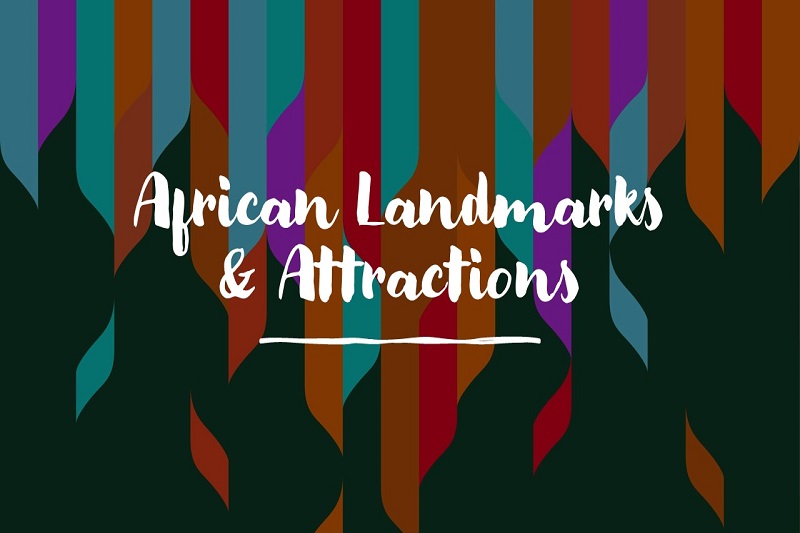
What famous and popular African landmark comes to your mind? Would it be the Pyramids of Giza in Egypt? This would be understandable because the pyramids are the most discussed man-made structures in history. But, when you consider Africa is the “Cradle of Civilization” you should expect that the second largest and populous continent with 54 countries would have a variety African landmarks. Your expectation would be correct, because there are African landmarks ranging from mountains, rivers, waterfalls, rock formations and old architecture.
There is something in Africa for everyone to enjoy, the hot region of the Sahara Desert, which stretches across the north. While in East Africa, you will find huge herds of wild animals grazing beneath the snowy Mount Kilimanjaro, Africa’s highest mountain.
In this article, we going to share twenty-four famous and popular African landmarks to visit.
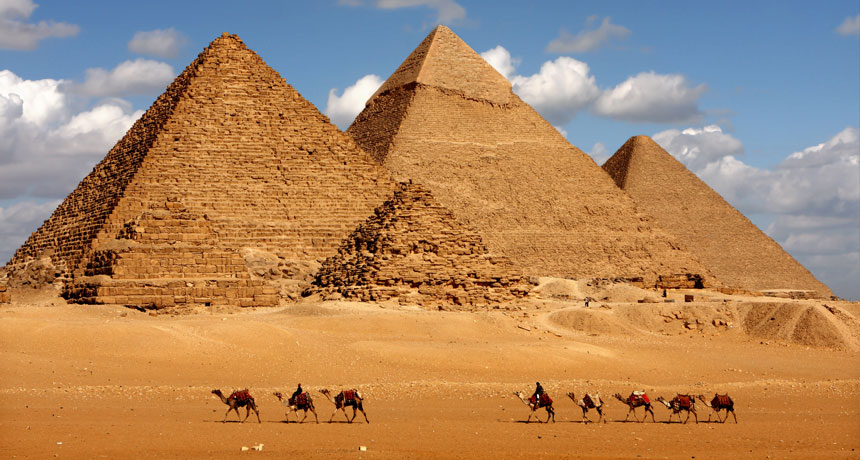
The Great Pyramid of Giza is the largest Egyptian pyramid and the tomb of Fourth Dynasty pharaoh Khufu. Built in the early 26th century BC during a period of around 27 years, the pyramid is the oldest of the Seven Wonders of the Ancient World, and the only one to remain largely intact. As part of the Giza pyramid complex, it borders present-day Giza in Greater Cairo, Egypt.
Initially standing at 146.6 metres (481 feet), the Great Pyramid was the tallest man-made structure in the world for more than 3,800 years. Over time, most of the smooth white limestone casing was removed, which lowered the pyramid’s height to the present 138.5 metres (454.4 ft). What is seen today is the underlying core structure. The base was measured to be about 230.3 metres (755.6 ft) square, giving a volume of roughly 2.6 million cubic metres (92 million cubic feet), which includes an internal hillock.
The dimensions of the pyramid were 280 royal cubits (146.7 m; 481.4 ft) high, a base length of 440 cubits (230.6 m; 756.4 ft), with a seked of 5+1/2 palms (a slope of 51°50’40”).
The Great Pyramid was built by quarrying an estimated 2.3 million large blocks weighing 6 million tonnes in total. The majority of stones are not uniform in size or shape and are only roughly dressed. The outside layers were bound together by mortar. Primarily local limestone from the Giza Plateau was used. Other blocks were imported by boat down the Nile: White limestone from Tura for the casing, and granite blocks from Aswan, weighing up to 80 tonnes, for the King’s Chamber structure.

The Nile River is a major north-flowing river in northeastern Africa. It flows into the Mediterranean Sea. The Nile River is the longest river in Africa and has historically been considered the longest river in the world, though this has been contested by research suggesting that the Amazon River is slightly longer. Of the world’s major rivers, the Nile River is one of the smallest, as measured by annual flow in cubic metres of water. About 6,650 km (4,130 mi)[a] long, its drainage basin covers eleven countries: the Democratic Republic of the Congo, Tanzania, Burundi, Rwanda, Uganda, Kenya, Ethiopia, Eritrea, South Sudan, Republic of the Sudan, and Egypt. In particular, the Nile River is the primary water source of Egypt, Sudan and South Sudan. Additionally, the Nile River is an important economic river, supporting agriculture and fishing.
The Nile River has two major tributaries – the White Nile and the Blue Nile. The White Nile is traditionally considered to be the headwaters stream. However, the Blue Nile is the source of most of the water of the Nile River downstream, containing 80% of the water and silt. The White Nile is longer and rises in the Great Lakes region. It begins at Lake Victoria and flows through Uganda and South Sudan. The Blue Nile begins at Lake Tana in Ethiopia and flows into Sudan from the southeast. The two rivers meet at the Sudanese capital of Khartoum.
The northern section of the river flows north almost entirely through the Nubian Desert to Cairo and its large delta, and the river flows into the Mediterranean Sea at Alexandria. Egyptian civilization and Sudanese kingdoms have depended on the river and its annual flooding since ancient times. Most of the population and cities of Egypt lie along those parts of the Nile River valley north of Aswan Dam. Nearly all the cultural and historical sites of Ancient Egypt developed and are found along river banks. The Nile River is, with the Rhône and Po, one of the three Mediterranean rivers with the largest water discharge.
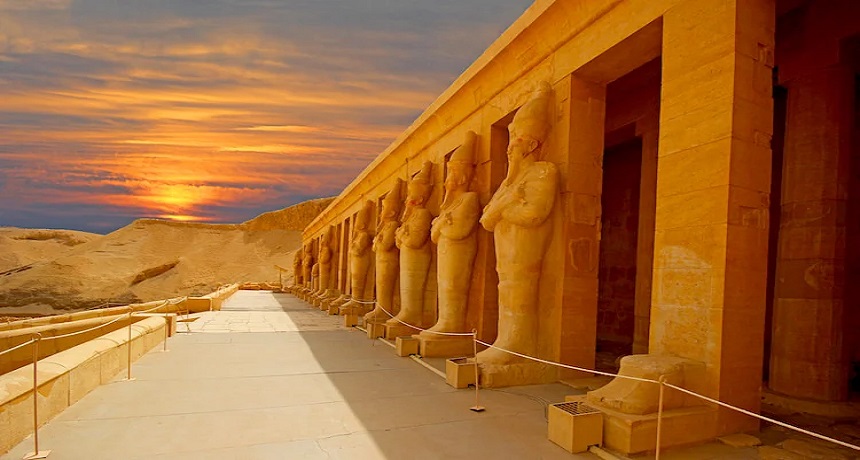
Valley of the Kings is a valley in Egypt where, for a period of nearly 500 years from the 16th to 11th century BC, rock-cut tombs were excavated for the pharaohs and powerful nobles of the New Kingdom (the Eighteenth to the Twentieth Dynasties of Ancient Egypt).
The valley stands on the west bank of the Nile opposite Thebes (modern Luxor), within the heart of the Theban Necropolis. The wadi consists of two valleys: the East Valley (where the majority of the royal tombs are situated) and the West Valley (Valley of the Monkeys).
With the 2005 discovery of a new chamber and the 2008 discovery of two further tomb entrances, the valley is known to contain 63 tombs and chambers (ranging in size from KV54, a simple pit, to KV5, a complex tomb with over 120 chambers). It was the principal burial place of the major royal figures of the Egyptian New Kingdom, as well as a number of privileged nobles. The royal tombs are decorated with scenes from Egyptian mythology and give clues as to the beliefs and funerary practices of the period. Almost all of the tombs seem to have been opened and robbed in antiquity, but they still give an idea of the opulence and power of the pharaohs.
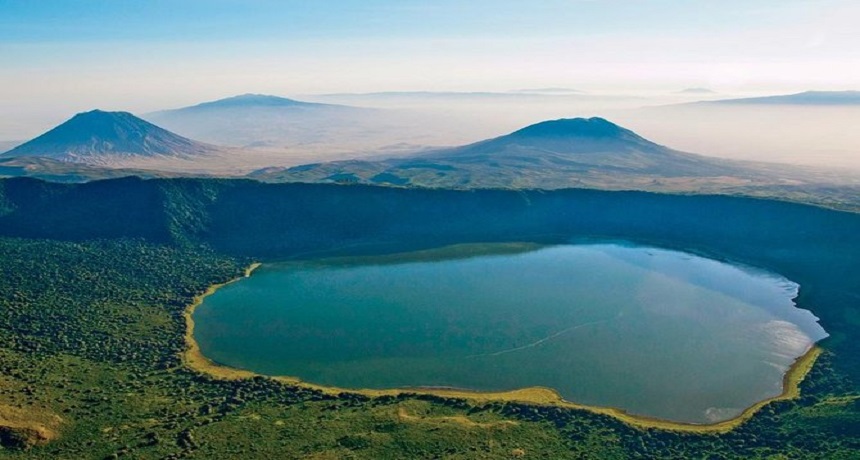
The Ngorongoro Crater is the best place in Tanzania to see ‘The Big Five’. A healthy population of black rhino and some of the largest tusker elephants left in Africa today are the prize spots, but the crater is also home to good populations of lion, leopard and hyena along with healthy herds of wildebeest, buffalo and zebra. Other wildlife here includes serval cat, cheetah, jackal, Grant’s and Thompson’s gazelle, flamingo and bat-eared foxes, as well as approximately 400 species of bird. A Ngorongoro safari is action packed to say the least – and for a relatively small park, it really does have the highest concentration of wildlife of any one place in the whole of Africa.
Credit: https://www.tanzaniaodyssey.com/tanzania/ngorongoro-crater
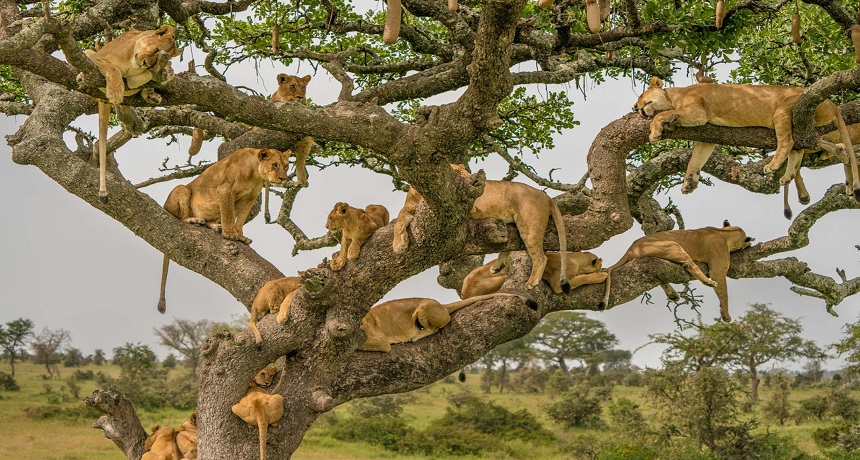
The Serengeti National Park is a large national park in northern Tanzania that stretches over 14,763 km2 (5,700 sq mi). It is located entirely in eastern Mara Region and north east portion of Simiyu Region and contains over 1,500,000 hectares (3,700,000 acres) of virgin savanna. The park was established in 1940.
The Serengeti is well known for the largest annual animal migration in the world of over 1.5 million blue wildebeest and 250,000 zebra along with smaller herds of Thomas’ Gazelle and eland.The national park is also home to the largest lion population in Africa. It is under threat from deforestation, population growth and ranching.
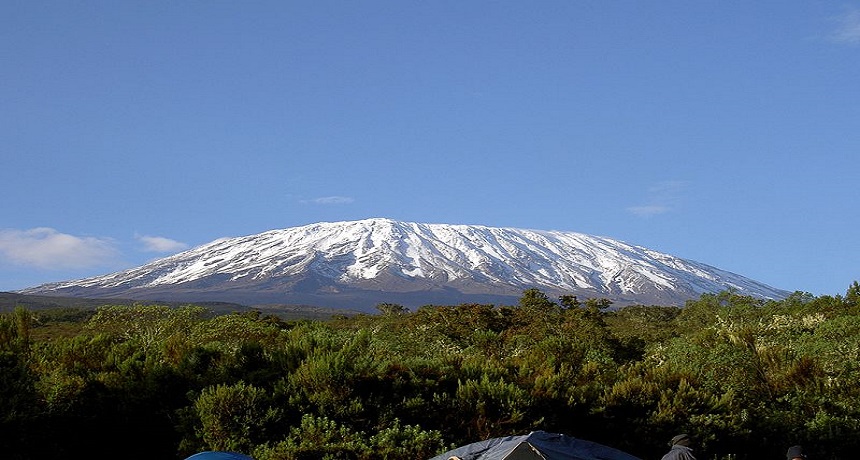
Mount Kilimanjaro is a dormant volcano in Tanzania. It has three volcanic cones: Kibo, Mawenzi, and Shira. It is the highest mountain in Africa and the highest single free-standing mountain above sea level in the world: 5,895 meters (19,341 ft) above sea level and about 4,900 meters (16,100 ft) above its plateau base. It is the highest volcano in Africa and the Eastern Hemisphere.
Kilimanjaro is the fourth most topographically prominent peak on Earth. It is part of Kilimanjaro National Park and is a major hiking and climbing destination. Because of its shrinking glaciers and ice fields, which are projected to disappear between 2025 and 2035, it has been the subject of many scientific studies.

The Olduvai Gorge or Oldupai Gorge in Tanzania is one of the most important paleoanthropological localities in the world; the many sites exposed by the gorge have proven invaluable in furthering understanding of early human evolution. A steep-sided ravine in the Great Rift Valley that stretches across East Africa, it is about 48 km (30 mi) long, and is located in the eastern Serengeti Plains within the Ngorongoro Conservation Area in the Olbalbal ward located in Ngorongoro District of Arusha Region, about 45 kilometres (28 miles) from Laetoli, another important archaeological locality of early human occupation.
The British/Kenyan paleoanthropologist-archeologist team of Mary and Louis Leakey established excavation and research programs at Olduvai Gorge that achieved great advances in human knowledge and are world-renowned. The site is registered as one of the National Historic Sites of Tanzania.
The gorge takes its name from the Maasai word oldupai which means “the place of the wild sisal” as the East African wild sisal (Sansevieria ehrenbergii) grows abundantly throughout the gorge area. Twenty-five kilometers downstream of Lake Ndutu and Lake Masek, the gorge cuts into Pleistocene lake bed sediments up to a depth of 90 m. A side gorge, originating from Lemagrut Mountain, joins the main gorge 8 km from the mouth. This side gorge follows the shoreline of a prehistoric lake, rich in fossils and early hominin sites. Periodic flows of volcanic ash from Olmoti and Kerimasi helped to ensure preservation of the fossils in the gorge.

Chefchaouen is a city in northwest Morocco. It is the chief town of the province of the same name, and is noted for its buildings in shades of blue. Chefchaouen is situated just inland from Tangier and Tétouan.
It was founded as a military outpost shortly before the Spanish Reconquista of Granada, and its population grew quickly with Muslim and Jewish immigrants fleeing from Spain. The economy is based on a traditional agro-pastoral system with olive and fig plantations; numerous water mills for grinding grain and olives; a handicrafts sector focusing on leather, iron, textiles and carpentry; and summer-dominated tourism.
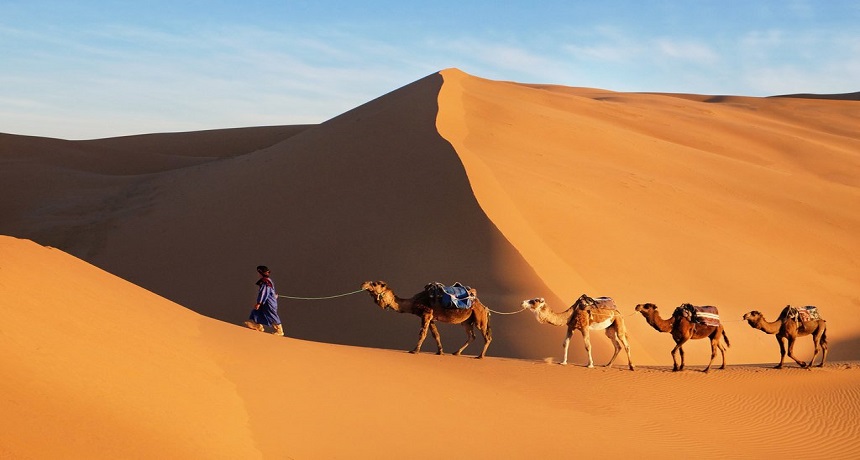
The Sahara is a desert on the African continent. With an area of 9,200,000 square kilometres (3,600,000 sq mi), it is the largest hot desert in the world and the third-largest desert overall, smaller only than the deserts of Antarctica and the northern Arctic.
The desert comprises much of North Africa, excluding the fertile region on the Mediterranean Sea coast, the Atlas Mountains of the Maghreb, and the Nile Valley in Egypt and the Sudan. It stretches from the Red Sea in the east and the Mediterranean in the north to the Atlantic Ocean in the west, where the landscape gradually changes from desert to coastal plains. To the south it is bounded by the Sahel, a belt of semi-arid tropical savanna around the Niger River valley and the Sudan region of sub-Saharan Africa. The Sahara can be divided into several regions, including the western Sahara, the central Ahaggar Mountains, the Tibesti Mountains, the Aïr Mountains, the Ténéré desert, and the Libyan Desert.
For several hundred thousand years, the Sahara has alternated between desert and savanna grassland in a 20,000-year cycle caused by the precession of Earth’s axis as it rotates around the Sun, which changes the location of the North African monsoon.
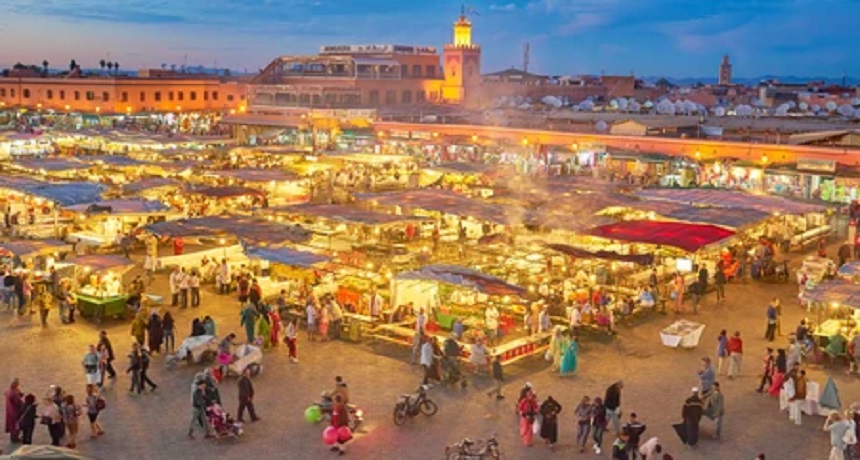
The Medina of Marrakech is located in the shadow of the high Atlas Mountains of central Morocco, about 250 km south of Casablanca. It was founded in the early years of the Almoravid dynasty, around 1062-70 with the first 7km circuit of walls built in 1126-27 to replace an earlier stockade of thorn bushes. It enjoyed a ‘golden age’ later in the 12th century, under the Almohad dynasty (1145-1250) when the famous Koutoubia Minaret was built. The fortunes of the city have waxed and waned over the centuries, but include several periods of notable architectural achievement, under the Saadian rulers (1510-1669) (when the Saadian tombs and the El Badi Palace were built) and the later Alawite dynasty (when the Menara and Agdal Gardens were re-designed and laid out as they remain today, 1822-59).
Credit: https://www.africanworldheritagesites.org/cultural-places/fortified-cities-of-the-maghreb/medina-of-marrakech.html

Omo National Park is a national park in Ethiopia founded in 1980. Located in the Southern Nations, Nationalities, and Peoples’ Region on the west bank of the Omo River, the park covers approximately 4,068 square kilometers, about 870 kilometers southwest of Addis Ababa; across the Omo is the Mago National Park and the Tama Wildlife Reserve. Although an airstrip was recently built near the park headquarters on the Mui River, this park is not easily reachable; the Lonely Planet guide Ethiopia and Eritrea describes Omo National Park as “Ethiopia’s most remote park.
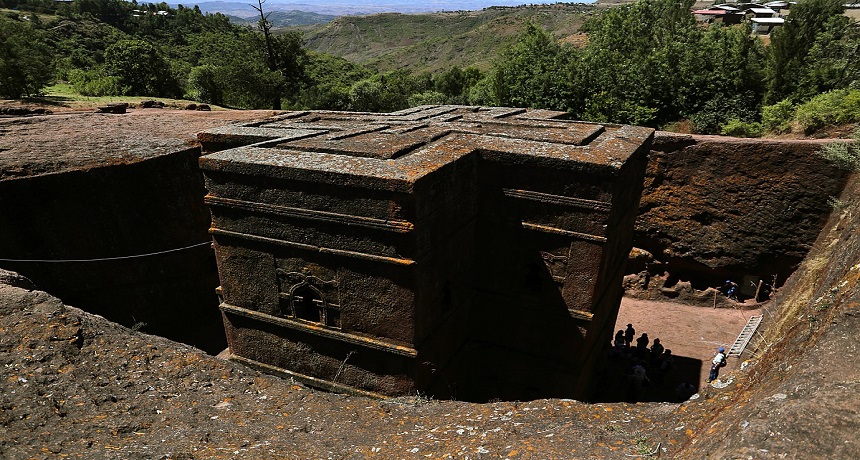
The eleven Rock-hewn Churches of Lalibela are monolithic churches located in the Western Ethiopian Highlands near the town of Lalibela, named after the late-12th and early-13th century King Gebre Mesqel Lalibela of the Zagwe Dynasty, who commissioned the massive building project of 11 rock-hewn churches to recreate the holy city of Jerusalem in his own kingdom. The site remains in use by the Ethiopian Orthodox Christian Church to this day, and it remains an important place of pilgrimage for Ethiopian Orthodox worshipers. It took 24 years to build all the 11 rock hewn churches.
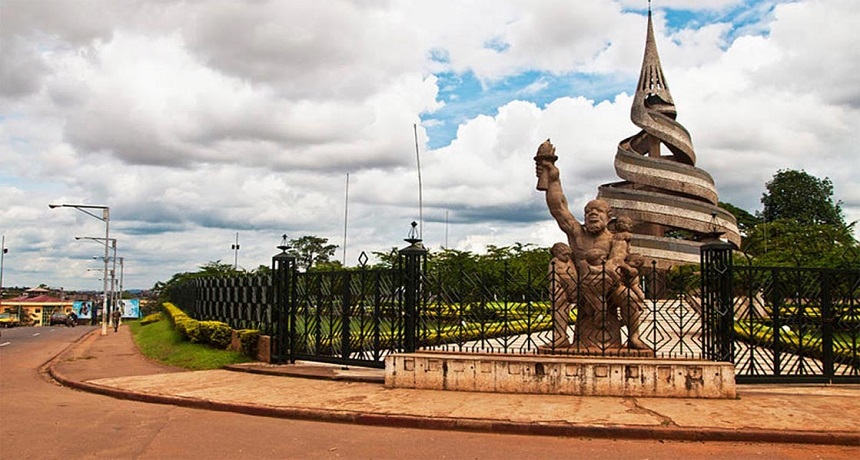
Cameroon’s Reunification Monument was constructed in the 1970s to commemorate the post-colonial merging of British and French Cameroon. The architects of the monument are Gedeon Mpondo and Engelbert Mveng.
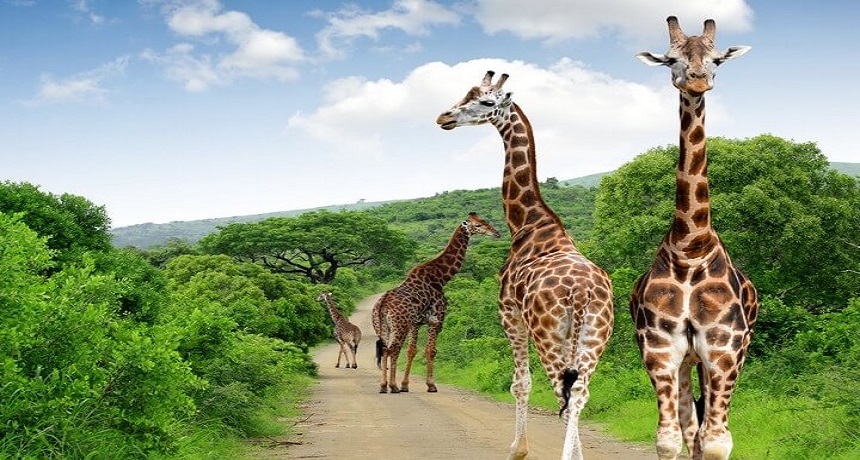
Kruger National Park is a South African National Park and one of the largest game reserves in Africa. It covers an area of 19,623 km2 (7,576 sq mi) in the provinces of Limpopo and Mpumalanga in northeastern South Africa, and extends 360 km (220 mi) from north to south and 65 km (40 mi) from east to west. The administrative headquarters are in Skukuza. Areas of the park were first protected by the government of the South African Republic in 1898, and it became South Africa’s first national park in 1926.
To the west and south of the Kruger National Park are the two South African provinces of Limpopo and Mpumalanga, respectively. To the north is Zimbabwe, and to the east is Mozambique. It is now part of the Great Limpopo Transfrontier Park, a peace park that links Kruger National Park with the Gonarezhou National Park in Zimbabwe, and with the Limpopo National Park in Mozambique.
The park is part of the Kruger to Canyons Biosphere, an area designated by the United Nations Educational, Scientific and Cultural Organization (UNESCO) as an International Man and Biosphere Reserve.
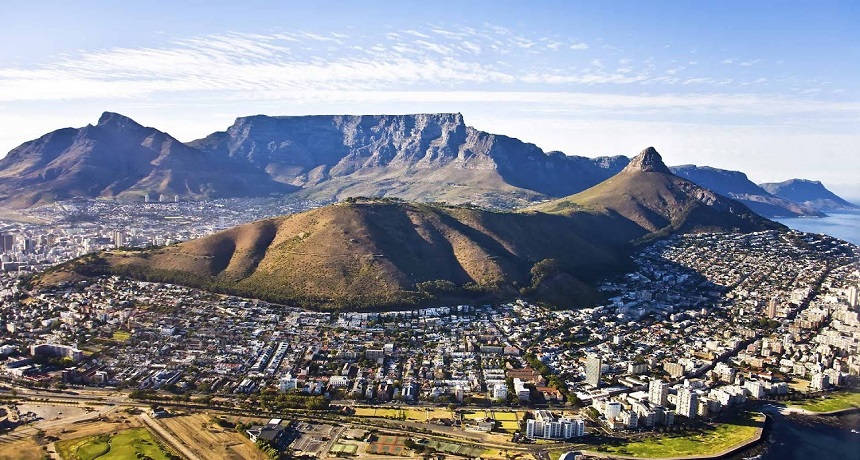
Table Mountain is a flat-topped mountain forming a prominent landmark overlooking the city of Cape Town in South Africa. It is a significant tourist attraction, with many visitors using the cableway or hiking to the top.[2] Table Mountain National Park is the most visited national park in South Africa, attracting 4.2 million people every year for various activities. The mountain has 8,200 plant species, of which around 80% are fynbos, meaning fine bush.[3] It forms part of the Table Mountain National Park, and part of the lands formerly ranged by Khoe-speaking clans, such as the !Uriǁʼaes (the “High Clan”). It is home to a large array of mostly endemic fauna and flora.

Maasai Mara, also sometimes spelled Masai Mara and locally known simply as The Mara, is a large national game reserve in Narok, Kenya, contiguous with the Serengeti National Park in Tanzania. It is named in honor of the Maasai people, the ancestral inhabitants of the area, who migrated to the area from the Nile Basin. Their description of the area when looked at from afar: “Mara” means “spotted” in the local Maasai language, due to the many short bushy trees which dot the landscape.
Maasai Mara is one of the most famous and important wildlife conservation and wilderness areas in Africa, world-renowned for its exceptional populations of lion, leopard, cheetah and African bush elephant. It also hosts the Great Migration, which secured it as one of the Seven Natural Wonders of Africa, and as one of the ten Wonders of the World.
The Greater Mara ecosystem encompasses areas known as the Maasai Mara National Reserve, the Mara Triangle, and several Maasai Conservancies, including Koiyaki, Lemek, Ol Chorro Oirowua, Mara North, Olkinyei, Siana, Maji Moto, Naikara, Ol Derkesi, Kerinkani, Oloirien, and Kimintet.
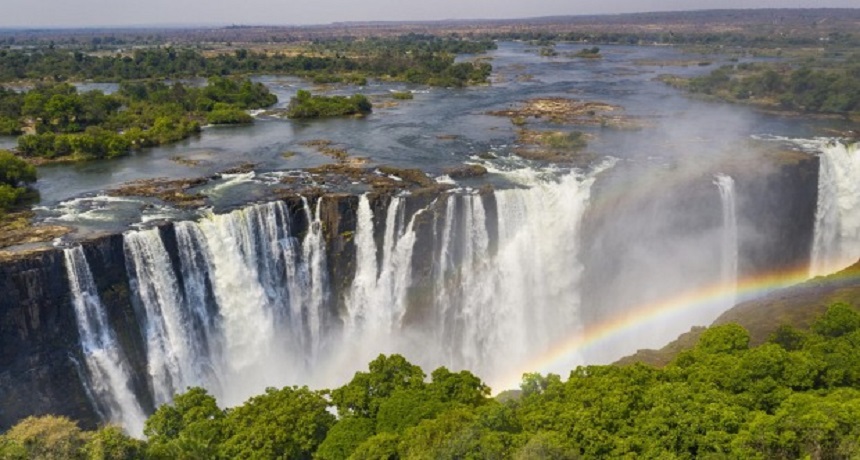
Victoria Falls is a waterfall on the Zambezi River in southern Africa, which provides habitat for several unique species of plants and animals. It is located on the border between Zambia and Zimbabwe and is one of the world’s largest waterfalls, with a width of 1,708 m (5,604 ft).

The Avenue of the Baobabs, or Alley of the Baobabs, is a prominent group of Grandidier’s baobabs (Adansonia grandidieri) lining the dirt road between Morondava and Belon’i Tsiribihina in the Menabe region of western Madagascar. Its striking landscape draws travelers from around the world, making it one of the most visited locations in the region. It has been a center of local conservation efforts, and was granted temporary protected status in July 2007 by the Ministry of Environment, Water and Forests – a step toward making it Madagascar’s first natural monument.
Along a 260 m (850 ft) stretch of the road is a grove of 20–25 Adansonia grandidieri baobabs. An additional 25 or so trees of this species are found growing over nearby rice paddies and meadows within 9.9 acres (4 ha) of land. The trees, which are endemic to Madagascar, are about 30 m (98 ft) in height.
The baobab trees, known locally as renala or reniala (from Malagasy reny ala “mother of the forest”), are up to 2,800 years old. They are a legacy of the dense tropical forests that once thrived on Madagascar. The trees did not originally tower in isolation over the sere landscape of scrub, but stood in dense forest. Over the years, as the country’s population grew, the forests were cleared for agriculture, leaving only the baobab trees, which the locals preserved as much for their own sake as for their value as a food source and building material.
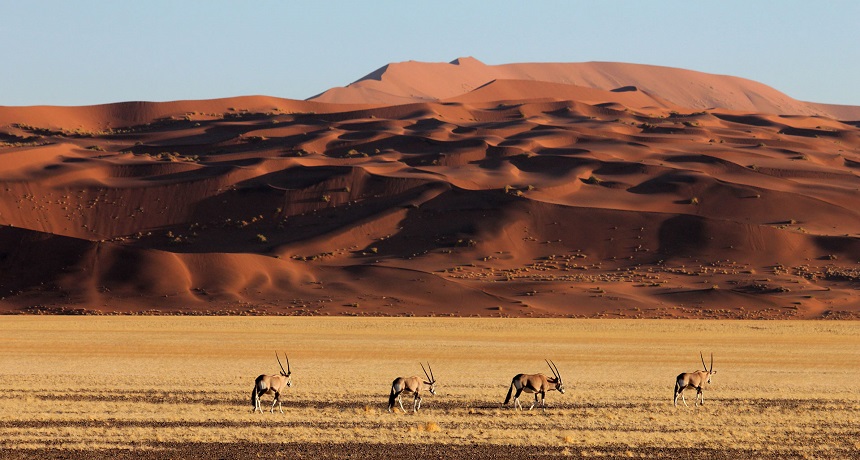
Sossusvlei s a salt and clay pan surrounded by high red dunes, located in the southern part of the Namib Desert, in the Namib-Naukluft National Park of Namibia. The name “Sossusvlei” is often used in an extended meaning to refer to the surrounding area (including other neighbouring vleis such as Deadvlei and other high dunes), which is one of the major visitor attractions of Namibia.
The name “Sossusvlei” is of mixed origin and roughly means “dead-end marsh”. Vlei is the Afrikaans word for “marsh”, while “sossus” is Nama for “no return” or “dead end”. Sossusvlei owes this name to the fact that it is an endorheic drainage basin (i.e., a drainage basin without outflows) for the ephemeral Tsauchab River.
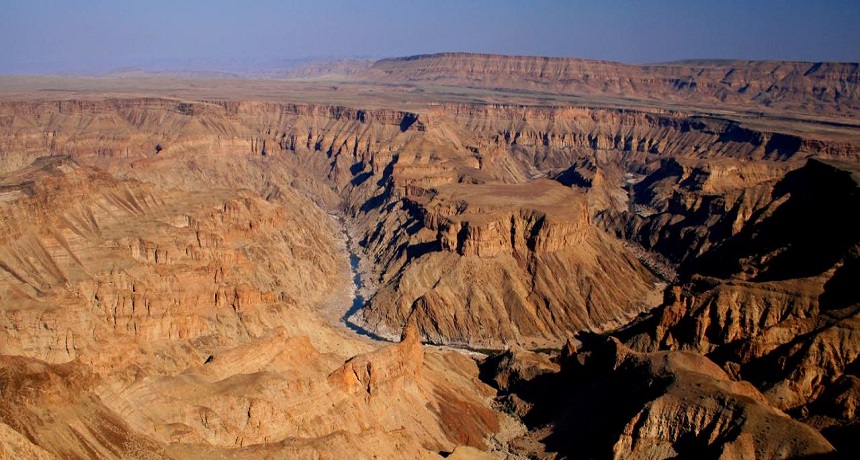
The Fish River Canyon is located in the south of Namibia. It is the largest canyon in Africa, as well as the second most visited tourist attraction in Namibia. It features a gigantic ravine, in total about 160 kilometres (100 mi) long, up to 27 km wide and in places almost 550 meters deep.
The Fish River is the longest interior river in Namibia. It cuts deep into the plateau which is today dry, stony and sparsely covered with hardy drought-resistant plants. The river flows intermittently, usually flooding in late summer; the rest of the year it becomes a chain of long narrow pools. At the lower end of the Fish River Canyon, the hot springs resort of ǀAi-ǀAis is situated.
Public view points are near Hobas, a camp site 70 km north of ǀAi-ǀAis. This part of the canyon is part of the ǀAi-ǀAis/Richtersveld Transfrontier Park. The other 90 km of this canyon are privately owned.
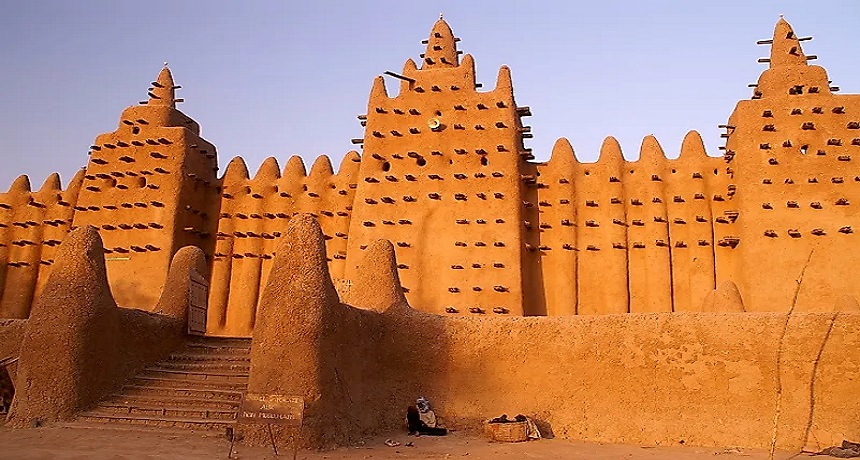
Timbuktu is a city in Mali, situated twenty kilometres (12 mi) north of the Niger River. The town is the capital of the Tombouctou Region, one of the eight administrative regions of Mali. It had a population of 54,453 in the 2009 census.
Timbuktu began as a seasonal settlement and became a permanent settlement early in the 12th century. After a shift in trading routes, particularly after the visit by Mansa Musa around 1325, Timbuktu flourished from the trade in salt, gold, ivory and slaves. It gradually expanded as an important Islamic city on the Saharan trade route and attracted many scholars and traders. It became part of the Mali Empire early in the 14th century. In the first half of the 15th century, the Tuareg people took control of the city for a short period until the expanding Songhai Empire absorbed the city in 1468. A Moroccan army defeated the Songhai in 1591 and made Timbuktu, rather than Gao, their capital.
The invaders established a new ruling class, the Arma, who after 1612 became virtually independent of Morocco. The golden age of the city, as a major learning and cultural centre of the Mali Empire, was over and it entered a long period of decline. Different tribes governed until the French took over in 1893, a situation that lasted until it became part of the Republic of Mali in 1960. Timbuktu is impoverished and suffers from desertification.
Gorilla Trekking in the Volcanoes National Park is popular because Rwanda is considered by some to be the best place to see gorillas in Africa. The Volcanoes National Park in Musanze is home to the intriguing but endangered mountain gorillas. Mountain gorillas are found in only 3 countries – Rwanda, Uganda and the Democratic Republic of Congo. They are also the only countries where tourists can spot mountain gorillas in the wild.
The Volcanoes National Park covers an area of about 16,000 hectares and is found in the northwestern part of Rwanda. It consists of afro-montane forests, bamboo forests, savanna grassland, vast swamps and 5 volcanoes (Bisoke, Gahinga, Muhabura, Sabyinyo and Karisimbi). Mount Karisimbi is one of the four tallest mountains in Africa.
The Volcanoes National Park is home to the spotted hyena, buffaloes, elephants, bush bucks, duikers and golden monkeys among many other mammals. Gorilla trekking is the most popular activity in the Volcanoes National Park and the chances of seeing mountain gorillas is Gorilla Tracking in Rwandavery high. Mountain gorilla trekking at the Volcanoes National Park involves hiking up a steep volcano through dense bamboo jungle in search of one of the gorilla families in Rwanda. The final encounter with the primates is considered one of the most exciting and memorable Wildlife encounters in Africa.
To have the best of both worlds, visitors can also go on a gorilla safari in both Uganda and Rwanda in what is a known as double gorilla trekking. Tracking gorillas is challenging but being able to finally see the gorillas is the ultimate wildlife experience.
Credit: https://www.silverbackgorillatours.com/practical-info-for-a-gorilla-trekking-in-rwanda
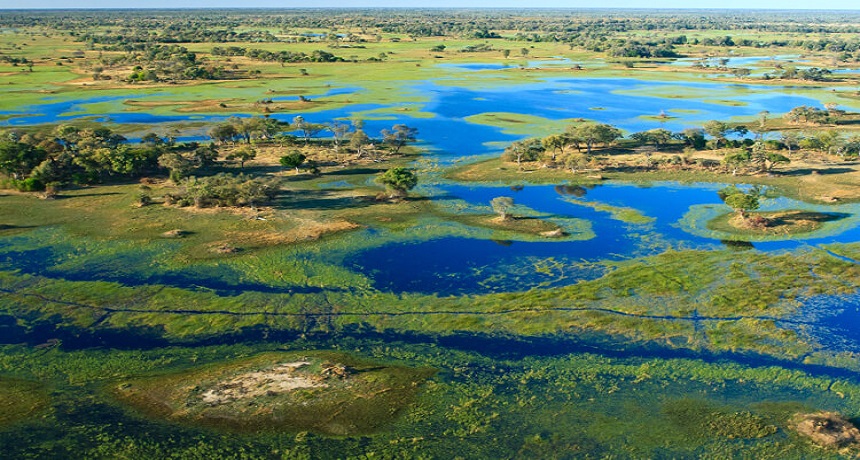
The Okavango Delta (or Okavango Grassland) (formerly spelled “Okovango” or “Okovanggo”) in Botswana is a swampy inland delta formed where the Okavango River reaches a tectonic trough at an altitude of 930–1,000 m[3] in the central part of the endorheic basin of the Kalahari. All the water reaching the delta is ultimately evaporated and transpired and does not flow into any sea or ocean. Each year, about 11 cubic kilometres (2.6 cu mi) of water spreads over the 6,000–15,000 km2 (2,300–5,800 sq mi) area. Some flood waters drain into Lake Ngami.[4] The area was once part of Lake Makgadikgadi, an ancient lake that had mostly dried up by the early Holocene.
The Moremi Game Reserve, a National Park, is on the eastern side of the delta. The delta was named as one of the Seven Natural Wonders of Africa, which were officially declared on 11 February 2013 in Arusha, Tanzania. On 22 June 2014, the Okavango Delta became the 1000th site to be officially inscribed on the UNESCO World Heritage List.

The Makgadikgadi Pan a salt pan situated in the middle of the dry savanna of north-eastern Botswana, is one of the largest salt flats in the world. The pan is all that remains of the formerly enormous Lake Makgadikgadi, which once covered an area larger than Switzerland, but dried up tens of thousands of years ago. Recent studies of human mitochondrial DNA suggest that modern Homo sapiens first began to evolve in this region some 200,000 years ago, when it was a vast, exceptionally fertile area of lakes, rivers, marshes, woodlands and grasslands especially favorable for habitation by evolving hominins and other mammals.

Introduction You’ve probably read a few books in your lifetime. But have you ever read a book that changed your life? That’s what Mildred D.

So you’re interested in becoming a podiatrist? That’s great! Podiatry is a fascinating and multifaceted field that can lead to a rewarding career. But before

If you’re not familiar with Sharon Flake, she’s a prolific author of young adult literature. Her books explore tough issues facing teenagers, from racism and

Hi, art lover! We wanted to introduce you to Shane W Evans, an extremely popular illustrator, and author. Evans was born in Columbus, Ohio, in